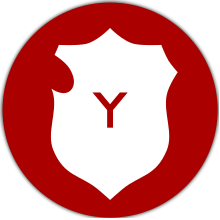221st Independent Infantry Brigade (Home)
The 221st Independent Infantry Brigade (Home) was a short-lived Home Defence formation of the British Army during World War II.
| 221st Independent Infantry Brigade (Home) | |
|---|---|
| Active | 8 November 1940 – 22 November 1941 |
| Country | |
| Branch | |
| Type | Infantry Brigade |
| Role | Training and Home Defence |
| Insignia | |
| Badge worn when in the Yorkshire County Division |  |
Origin and Service
The 221st Independent Infantry Brigade (Home) was formed for service in the United Kingdom under the Chatham Area headquarters of Home Forces on 8 November 1940. It was commanded by Brigadier C.H. Gotto, and comprised three newly raised infantry battalions [1] After a brief spell attached to the 2nd Infantry Division, the Brigade became part of the Yorkshire County Division (later East Riding Coastal Area) on 19 March 1941.[2] The brigade was disbanded on 22 December 1941.[1]
Order of battle
The composition of 221 Brigade was as follows:[1]
- 11th Battalion, Gloucestershire Regiment (8 November — 11 December 1941, converted early 1942 into the 118th Light Anti-Aircraft Regiment, Royal Artillery)[3]
- 10th Battalion, Queen's Own Royal West Kent Regiment (8 November — 11 December 1941, converted early 1942 into the 119th Light Anti-Aircraft Regiment, Royal Artillery)[4]
- 7th Battalion, King's Shropshire Light Infantry (8 November 1940 — 29 November 1941, converted that year into the 99th Anti-Tank Regiment, Royal Artillery)[5]
Notes
- Joslen, p. 384.
- Joslen, pp. 117, 384.
- Evans, Nigle F. "118 Light AA Regiment RA (TA)". The Royal Artillery 1939-45. Archived from the original on 10 July 2015. Retrieved 8 January 2017.CS1 maint: BOT: original-url status unknown (link)
- Evans, Nigle F. "119 Light AA Regiment RA (TA)". The Royal Artillery 1939-45. Archived from the original on 23 July 2015. Retrieved 8 January 2017.CS1 maint: BOT: original-url status unknown (link)
- "Anti-Tank Regiments". British Artillery Regiments in World War 2. Retrieved 8 January 2017.
gollark: If you dislike it, run it yourself with your "better" name.
gollark: I heard it somewhere.
gollark: Um, I'll do that next.
gollark: Inevitably, and inescapably.
gollark: `the Macron programming language, by LyricLy Christina #vfxfriday 20 megapixels`
References
- Lt-Col H.F. Joslen, Orders of Battle, United Kingdom and Colonial Formations and Units in the Second World War, 1939–1945, London: HM Stationery Office, 1960/Uckfield: Naval & Military, 2003, ISBN 1843424746.
This article is issued from Wikipedia. The text is licensed under Creative Commons - Attribution - Sharealike. Additional terms may apply for the media files.